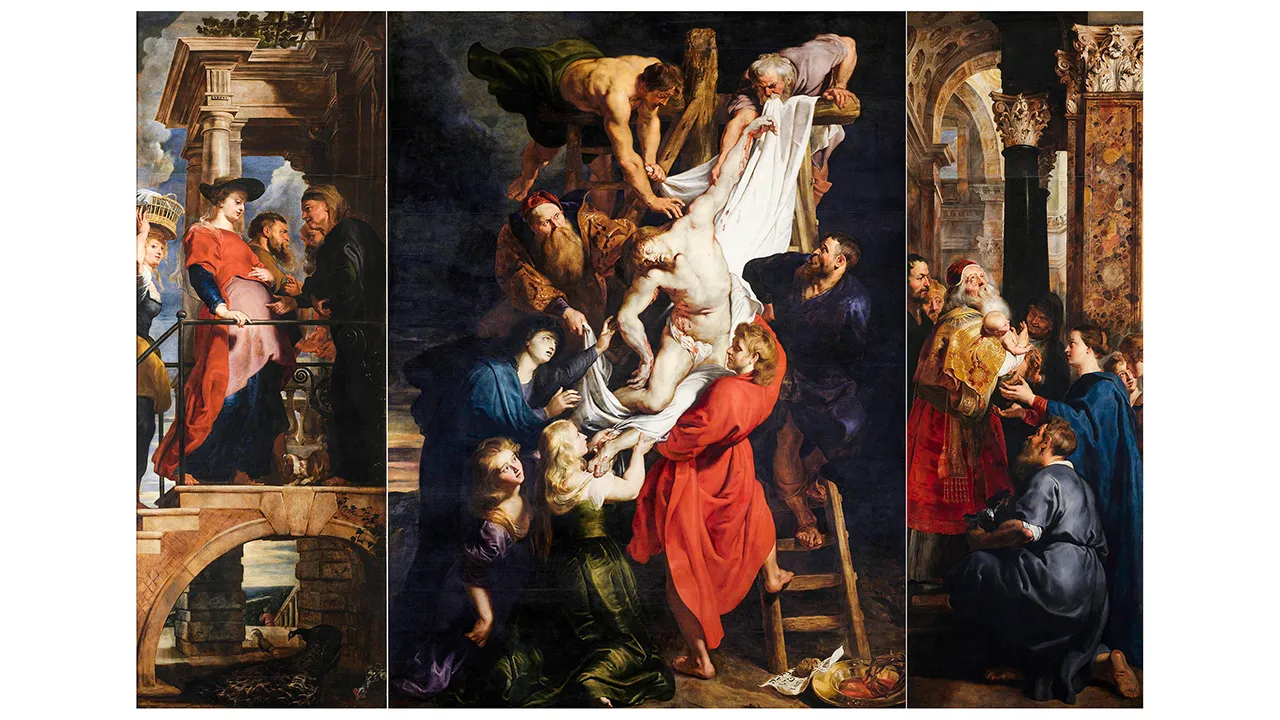
Robert Draws – The Descent from the Cross by Peter Paul Rubens is a masterpiece of Baroque art. This painting vividly depicts the moment Christ’s body is taken down from the cross after His crucifixion. Rubens expertly captures the emotional intensity of the scene, conveying both sorrow and reverence. The composition is grand and full of movement, offering a poignant representation of sacrifice, grief, and hope.
Rubens’ The Descent from the Cross stands out with its dramatic flair. The composition swirls with figures, capturing the action of lowering Christ’s body. The scene feels chaotic, yet Rubens controls it masterfully, arranging his subjects with precision. Several figures hold Christ’s lifeless body, symbolizing the sorrow of His followers. Their expressions show deep sadness and reverence for the fallen Savior.
The contrast between light and shadow adds depth to the painting. Rubens uses light to highlight the central figures, guiding the viewer’s eye to Christ’s body. This focus amplifies the emotional impact of the scene. The surrounding figures fade slightly into shadow, making Christ’s sacrifice the undeniable focal point of the painting.
“Read about: The School of Athens: Raphael’s Masterpiece of Renaissance Philosophy”
The central theme of The Descent from the Cross is Christ’s ultimate sacrifice for humanity. The moment depicted is one of profound sorrow, yet it also holds a sense of reverence and devotion. Rubens portrays Christ’s body in a state of vulnerability, yet the figures around Him provide comfort and care. This shows the profound love and respect His followers held for Him.
The position of Christ’s body also carries symbolic meaning. His limp form is gently cradled by His followers, emphasizing the sorrowful reality of His death. The careful positioning suggests His humanity, reminding the viewer that Christ was both divine and human. His sacrifice is, therefore, not just a divine act but also a deeply human experience.
The figures surrounding Christ play an essential role in this depiction. The Virgin Mary, with her grief-stricken face, is positioned near Christ’s body. Her sorrow is palpable, and her gesture reflects the heartache of a mother who has lost her son. The other figures, including St. John and Mary Magdalene, also express deep grief, yet their postures suggest devotion and compassion.
Rubens’ attention to detail in the faces and gestures of the figures makes each one emotionally compelling. Their sorrow is not only visual but also deeply felt. This connection between Christ and His followers underscores the profound emotional bond that existed between them.
Rubens’ use of color is vital in communicating the intensity of the scene. The warm, rich tones of the figures contrast with the cooler background, drawing attention to the central characters. The gold and red tones of the robes signify royalty and divinity, while the dark shadows around Christ’s body highlight His human suffering. The strategic placement of light further emphasizes Christ’s form, making Him the central focus of the painting.
The interplay between light and dark also conveys the spiritual significance of the moment. It suggests the divine nature of Christ’s sacrifice while emphasizing His physical suffering. Rubens’ mastery of light and color enhances the emotional gravity of the scene.
“Read more: Tina’s Triumph: Rising Above the Trauma of Human Trafficking”
One of the most striking aspects of The Descent from the Cross is its sense of movement. The figures seem to be caught in the act of lowering Christ’s body, creating a dynamic, almost chaotic scene. Despite the movement, there is a tenderness in the way Christ is handled. The viewer can sense the reverence in the figures’ gestures, making the scene all the more emotional.
Rubens expertly uses movement to depict the sorrow and the reverence felt by those around Christ. The figures’ postures and expressions communicate grief, yet there is an underlying sense of love and devotion. This emotional depth is one of the key reasons the painting resonates so strongly with viewers.
As a Baroque artist, Rubens was known for his emotional intensity and dramatic compositions. In The Descent from the Cross, Rubens brings these characteristics to life. The emotional power of the scene is amplified through his use of vivid colors, dramatic light, and expressive figures. The painting draws the viewer into the moment, making them feel the profound grief and reverence of the scene.
Baroque art often emphasizes human emotion and spirituality, and Rubens’ work is a prime example. The emotional complexity of The Descent from the Cross demonstrates Rubens’ mastery in capturing the intensity of both human suffering and divine sacrifice.